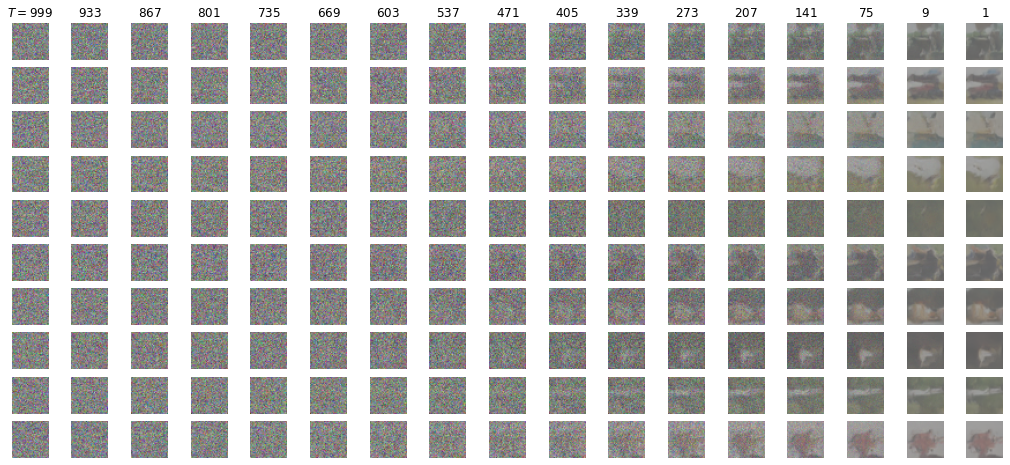6.3. Diffusion Probabilistic Model#
The materials in this notebook are inspired from:
This tutorial covers the basics of Denoising Diffusion Probabilistic Models (DDPM). In a DDMP, the network learns to gradually denoise data:
Fixed forward diffusion process gradually adds Gaussian noise to an image.
Generative reverse denoising process gradually learns to denoise an image.

This process (adding noise and denoising) happens at \(T\) steps, a nice property of this process is that we can sample \(X\) at any arbitrary \(t\) step.
We explore a few new toy examples all in images of small resolution (\(\le32 \times 32\)):
MNIST: grey-scale digit recognition from 0 to 9.

Fashion-MNIST grey-scale image recognition among 10 categories.
CIFAR10: object recognition among 10 categories.
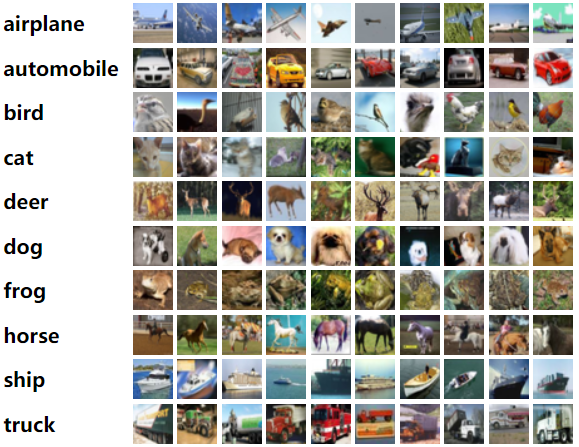
0. Packages#
Let’s start with all the necessary packages to implement this tutorial.
numpy is the main package for scientific computing with Python. It’s often imported with the
npshortcut.argparse is a module making it easy to write user-friendly command-line interfaces.
matplotlib is a library to plot graphs in Python.
os provides a portable way of using operating system-dependent functionality, e.g., modifying files/folders.
torch is a deep learning framework that allows us to define networks, handle datasets, optimise a loss function, etc.
# importing the necessary packages/libraries
import numpy as np
import argparse
from matplotlib import pyplot as plt
import random
import os
import math
import torch
import torch.nn as nn
import torch.nn.functional as torch_f
import torchvision
device#
Choosing CPU or GPU based on the availability of the hardware.
device = torch.device('cuda' if torch.cuda.is_available() else 'cpu')
arguments#
We use the argparse module to define a set of parameters that we use throughout this notebook:
The
argparseis particularly useful when writing Python scripts, allowing you to run the same script with different parameters (e.g., for doing different experiments).In notebooks using
argparseis not necessarily beneficial, we could have hard-coded those values directly in variables, but here we useargparsefor learning purposes.
parser = argparse.ArgumentParser()
parser.add_argument("--n_epochs", type=int, default=20, help="number of epochs of training")
parser.add_argument("--batch_size", type=int, default=128, help="size of the batches")
parser.add_argument("--lr", type=float, default=2e-4, help="adam: learning rate")
parser.add_argument("--b1", type=float, default=0.9, help="adam: decay of first order momentum of gradient")
parser.add_argument("--b2", type=float, default=0.999, help="adam: decay of first order momentum of gradient")
parser.add_argument("--diffusion_steps", type=int, default=1000, help="number of diffusion steps")
parser.add_argument("--img_size", type=int, default=32, help="size of each image dimension")
parser.add_argument("--channels", type=int, default=1, help="number of image channels")
parser.add_argument("--sample_interval", type=int, default=500, help="interval between image sampling")
parser.add_argument("--out_dir", type=str, default="./dmp_out/", help="the output directory")
parser.add_argument("--dataset", type=str, default="mnist",
choices=["mnist", "fashion-mnist", "cifar10"], help="which dataset to use")
def set_args(*args):
# we can pass arguments to the parse_args function to change the default values.
opt = parser.parse_args([*args])
# adding the dataset to the out dir to avoid overwriting the generated images
opt.out_dir = "%s/%s/" % (opt.out_dir, opt.dataset)
# the images in cifar10 are colourful
if opt.dataset == "cifar10":
opt.channels = 3
# creating the output directory
os.makedirs(opt.out_dir, exist_ok=True)
return opt
opt = set_args("--n_epochs", "10", "--dataset", "mnist")
print(opt)
Namespace(n_epochs=10, batch_size=128, lr=0.0002, b1=0.9, b2=0.999, diffusion_steps=1000, img_size=32, channels=1, sample_interval=500, out_dir='./dmp_out//mnist/', dataset='mnist')
Architecture#
class SelfAttention(nn.Module):
def __init__(self, h_size):
super(SelfAttention, self).__init__()
self.h_size = h_size
self.mha = nn.MultiheadAttention(h_size, 4, batch_first=True)
self.ln = nn.LayerNorm([h_size])
self.ff_self = nn.Sequential(
nn.LayerNorm([h_size]),
nn.Linear(h_size, h_size),
nn.GELU(),
nn.Linear(h_size, h_size),
)
def forward(self, x):
x_ln = self.ln(x)
attention_value, _ = self.mha(x_ln, x_ln, x_ln)
attention_value = attention_value + x
attention_value = self.ff_self(attention_value) + attention_value
return attention_value
class SAWrapper(nn.Module):
def __init__(self, h_size, num_s):
super(SAWrapper, self).__init__()
self.sa = nn.Sequential(*[SelfAttention(h_size) for _ in range(1)])
self.num_s = num_s
self.h_size = h_size
def forward(self, x):
x = x.view(-1, self.h_size, self.num_s * self.num_s).swapaxes(1, 2)
x = self.sa(x)
x = x.swapaxes(2, 1).view(-1, self.h_size, self.num_s, self.num_s)
return x
# U-Net code adapted from: https://github.com/milesial/Pytorch-UNet
class DoubleConv(nn.Module):
def __init__(self, in_channels, out_channels, mid_channels=None, residual=False):
super().__init__()
self.residual = residual
if not mid_channels:
mid_channels = out_channels
self.double_conv = nn.Sequential(
nn.Conv2d(in_channels, mid_channels, kernel_size=3, padding=1, bias=False),
nn.GroupNorm(1, mid_channels),
nn.GELU(),
nn.Conv2d(mid_channels, out_channels, kernel_size=3, padding=1, bias=False),
nn.GroupNorm(1, out_channels),
)
def forward(self, x):
return torch_f.gelu(x + self.double_conv(x)) if self.residual else self.double_conv(x)
class Down(nn.Module):
def __init__(self, in_channels, out_channels):
super().__init__()
self.maxpool_conv = nn.Sequential(
nn.MaxPool2d(2),
DoubleConv(in_channels, in_channels, residual=True),
DoubleConv(in_channels, out_channels),
)
def forward(self, x):
return self.maxpool_conv(x)
class Up(nn.Module):
def __init__(self, in_channels, out_channels, bilinear=True):
super().__init__()
# if bilinear, use the normal convolutions to reduce the number of channels
if bilinear:
self.up = nn.Upsample(scale_factor=2, mode="bilinear", align_corners=True)
self.conv = DoubleConv(in_channels, in_channels, residual=True)
self.conv2 = DoubleConv(in_channels, out_channels, in_channels // 2)
else:
self.up = nn.ConvTranspose2d(in_channels, in_channels // 2, kernel_size=2, stride=2)
self.conv = DoubleConv(in_channels, out_channels)
def forward(self, x1, x2):
x1 = self.up(x1)
# input is CHW
diffY = x2.size()[2] - x1.size()[2]
diffX = x2.size()[3] - x1.size()[3]
x1 = torch_f.pad(x1, [diffX // 2, diffX - diffX // 2, diffY // 2, diffY - diffY // 2])
x = torch.cat([x2, x1], dim=1)
x = self.conv(x)
x = self.conv2(x)
return x
class DiffusionModel(nn.Module):
def __init__(self, opt):
super(DiffusionModel, self).__init__()
self.beta_small = 1e-4
self.beta_large = 0.02
self.t_range = opt.diffusion_steps
self.in_size = opt.img_size ** 2
bilinear = True
self.inc = DoubleConv(opt.channels, 64)
self.down1 = Down(64, 128)
self.down2 = Down(128, 256)
factor = 2 if bilinear else 1
self.down3 = Down(256, 512 // factor)
self.up1 = Up(512, 256 // factor, bilinear)
self.up2 = Up(256, 128 // factor, bilinear)
self.up3 = Up(128, 64, bilinear)
self.outc = nn.Conv2d(64, opt.channels, kernel_size=1)
self.sa1 = SAWrapper(256, 8)
self.sa2 = SAWrapper(256, 4)
self.sa3 = SAWrapper(128, 8)
def pos_encoding(self, t, channels, embed_size):
inv_freq = 1.0 / (10000 ** (torch.arange(0, channels, 2, device=device).float() / channels))
pos_enc_a = torch.sin(t.repeat(1, channels // 2) * inv_freq)
pos_enc_b = torch.cos(t.repeat(1, channels // 2) * inv_freq)
pos_enc = torch.cat([pos_enc_a, pos_enc_b], dim=-1)
return pos_enc.view(-1, channels, 1, 1).repeat(1, 1, embed_size, embed_size)
def forward(self, x, t):
"""Model is U-Net with added positional encodings and self-attention layers."""
x1 = self.inc(x)
x2 = self.down1(x1) + self.pos_encoding(t, 128, 16)
x3 = self.down2(x2) + self.pos_encoding(t, 256, 8)
x3 = self.sa1(x3)
x4 = self.down3(x3) + self.pos_encoding(t, 256, 4)
x4 = self.sa2(x4)
x = self.up1(x4, x3) + self.pos_encoding(t, 128, 8)
x = self.sa3(x)
x = self.up2(x, x2) + self.pos_encoding(t, 64, 16)
x = self.up3(x, x1) + self.pos_encoding(t, 64, 32)
output = self.outc(x)
return output
def beta(self, t):
return self.beta_small + (t / self.t_range) * (self.beta_large - self.beta_small)
def alpha(self, t):
return 1 - self.beta(t)
def alpha_bar(self, t):
return math.prod([self.alpha(j) for j in range(t)])
def get_loss(self, batch): # TODO batch_idx
"""Corresponds to Algorithm 1 from (Ho et al., 2020)."""
# for each sample in the batch we create a random time step t
ts = torch.randint(0, self.t_range, [batch.shape[0]], device=device)
# the fixed forward diffusion process gradually adds Gaussian noise to an image.
noise_imgs = []
epsilons = torch.randn(batch.shape, device=device)
for i in range(len(ts)):
a_hat = self.alpha_bar(ts[i])
noise_imgs.append((math.sqrt(a_hat) * batch[i]) + (math.sqrt(1 - a_hat) * epsilons[i]))
noise_imgs = torch.stack(noise_imgs, dim=0)
# the generative reverse denoising process gradually learns to denoise an image.
e_hat = self.forward(noise_imgs, ts.unsqueeze(-1).type(torch.float))
# computing the loss
loss = torch_f.mse_loss(e_hat.reshape(-1, self.in_size), epsilons.reshape(-1, self.in_size))
return loss
def denoise_sample(self, x, t):
"""Corresponds to the inner loop of Algorithm 2 from (Ho et al., 2020)."""
with torch.no_grad():
z = torch.randn(x.shape, device=device) if t > 1 else 0
e_hat = self.forward(x, t.view(1, 1).repeat(x.shape[0], 1))
pre_scale = 1 / math.sqrt(self.alpha(t))
e_scale = (1 - self.alpha(t)) / math.sqrt(1 - self.alpha_bar(t))
post_sigma = math.sqrt(self.beta(t)) * z
x = pre_scale * (x - e_scale * e_hat) + post_sigma
return x
Dataset#
We explore three datasets all already implemented in torchvision. The first time will be automatically downloaded (in “./data/” directory) the first time if already it doesn’t exist.
def get_dataloader(opt, transform):
if opt.dataset == "mnist":
dataset = torchvision.datasets.MNIST("./data/", train=True, download=True, transform=transform)
elif opt.dataset == "fashion-mnist":
dataset = torchvision.datasets.FashionMNIST("./data/", train=True, download=True, transform=transform)
else:
dataset = torchvision.datasets.cifar.CIFAR10("./data/", train=True, download=True, transform=transform)
return torch.utils.data.DataLoader(dataset, batch_size=opt.batch_size, shuffle=True)
Transform functions#
We resize all images to specified image size (opt.img_size), converting them to Tensor and normalising the inputs (Normalize).
# make the pytorch datasets
mean = 0.5
std = 0.5
transform = torchvision.transforms.Compose([
torchvision.transforms.Resize(opt.img_size),
torchvision.transforms.ToTensor(),
torchvision.transforms.Normalize(mean, std)
])
dataloader = get_dataloader(opt, transform)
Visualisation#
Let’s visualise a few samples from our dataset.
fig = plt.figure(figsize=(5, 5))
for i in range(25):
img, target = dataloader.dataset.__getitem__(i)
ax = fig.add_subplot(5, 5, i+1)
ax.imshow(img.numpy().transpose(1, 2, 0) * std + mean, cmap='gray')
ax.axis('off')
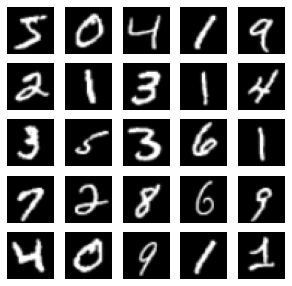
Training#
Setup Networks and Optimiser#
def setup_training(opt):
# Initialise network
network = DiffusionModel(opt).to(device)
# Optimiser
optimizer = torch.optim.Adam(network.parameters(), lr=opt.lr, betas=(opt.b1, opt.b2))
return network, optimizer
Utility functions#
def sample_image(model, batches_done, opt, saveimg=False, samples=10, steps=15):
"""Saves a grid of generated images."""
x = torch.randn((samples, opt.channels, opt.img_size, opt.img_size)).to(device)
diffusion_steps = torch.arange(model.t_range-1, 0, -1).to(device)
tosave_steps = [*diffusion_steps[::len(diffusion_steps) // steps], diffusion_steps[-1]]
gen_imgs = []
with torch.no_grad():
for t in diffusion_steps:
x = model.denoise_sample(x, t)
if t in tosave_steps:
gen_imgs.append(x)
gen_imgs = torch.stack(gen_imgs, dim=0)
if saveimg:
gen_imgs = gen_imgs.view(-1, opt.channels, opt.img_size, opt.img_size)
torchvision.utils.save_image(
gen_imgs.data, "%s/%.7d.png" % (opt.out_dir, batches_done), nrow=10, normalize=True
)
else:
return gen_imgs, tosave_steps
The training loop follows standard steps. The only difference is that we call the network.get_loss() function instead of the usual calling of the forward function by passing inputs to the network.:
The
get_lossfunction internally calls theforwardfunction.The
get_lossfunction also computes the loss value using MSE and returns it.
def train_instance(opt):
network, optimiser = setup_training(opt)
losses = []
for epoch in range(opt.n_epochs):
for batch_ind, (imgs, _) in enumerate(dataloader):
imgs = imgs.to(device)
loss = network.get_loss(imgs)
optimiser.zero_grad()
loss.backward()
optimiser.step()
losses.append(loss.item())
batches_done = epoch * len(dataloader) + batch_ind
if batches_done % opt.sample_interval == 0:
sample_image(network, batches_done, opt, saveimg=True)
print(
"[Epoch %d/%d] [Batch %d/%d] [loss: %f]"
% (epoch, opt.n_epochs, batch_ind, len(dataloader), np.mean(losses))
)
return network, losses
Results#
Let’s train our DDPM with current arguments (opt).
Training progress:
loss value we can observe that the MSE (L2 norm) is gradually decreasing.
reconstructed images By looking at the reconstructed images (in the
opt.out_dirfolder), we can observe that the quality of generated images is quite good. In other words, the network has learnt to denoise the input at each diffusion step.
model, losses = train_instance(opt)
[Epoch 0/10] [Batch 0/469] [loss: 1.364887]
[Epoch 1/10] [Batch 31/469] [loss: 0.093262]
[Epoch 2/10] [Batch 62/469] [loss: 0.063589]
[Epoch 3/10] [Batch 93/469] [loss: 0.052443]
[Epoch 4/10] [Batch 124/469] [loss: 0.046110]
[Epoch 5/10] [Batch 155/469] [loss: 0.042119]
[Epoch 6/10] [Batch 186/469] [loss: 0.039171]
[Epoch 7/10] [Batch 217/469] [loss: 0.036970]
[Epoch 8/10] [Batch 248/469] [loss: 0.035148]
[Epoch 9/10] [Batch 279/469] [loss: 0.033649]
plt.figure(figsize=(10,5))
plt.title("Loss During Training")
plt.plot(losses)
plt.xlabel("iterations")
plt.ylabel("Loss")
plt.show()

Generating#
def normalise(x, low= 0, high=1):
"""Normalise a signal between the low and high values."""
minv = np.min(x)
maxv = np.max(x)
# This is the equation for min-max normalisation https://en.wikipedia.org/wiki/Feature_scaling
return low + (x - minv) * (high - low) / (maxv - minv)
def plot_gen_imgs(gen_imgs):
gen_imgs = normalise(gen_imgs)
fig = plt.figure(figsize=(18, 8))
ax_ind = 1
for i in range(gen_imgs.shape[1]):
for t in range(gen_imgs.shape[0]):
ax = fig.add_subplot(gen_imgs.shape[1], gen_imgs.shape[0], ax_ind)
ax.imshow(gen_imgs[t, i], cmap='gray')
ax.axis('off')
ax_ind += 1
if i == 0:
ax.set_title("$T=%d$" % steps[t] if t == 0 else "$%d$" % steps[t])
gen_imgs, steps = sample_image(model, None, opt, saveimg=False)
gen_imgs = gen_imgs.detach().cpu().numpy().transpose(0, 1, 3, 4, 2)
plot_gen_imgs(gen_imgs)
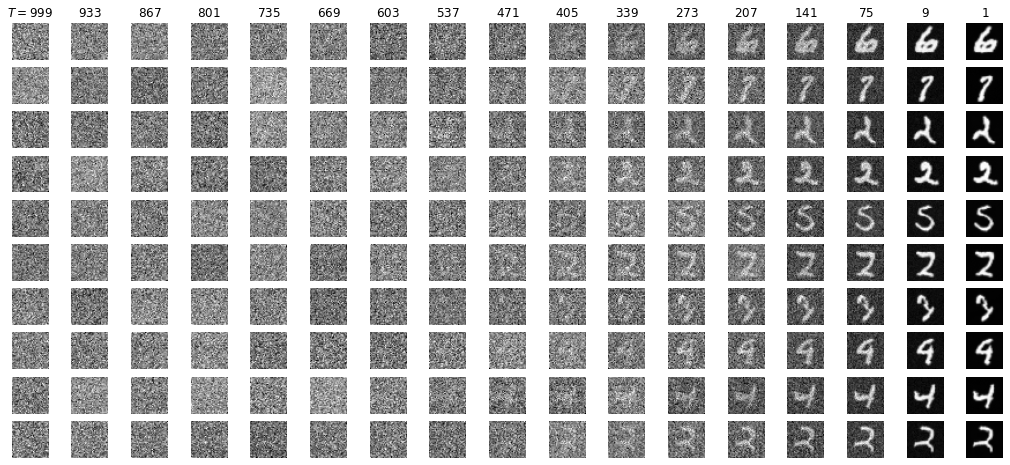
Another dataset#
Let’s play with another dataset!
opt = set_args("--n_epochs", "30", "--dataset", "cifar10")
print(opt)
dataloader = get_dataloader(opt, transform)
fig = plt.figure(figsize=(5, 5))
for i in range(25):
img, target = dataloader.dataset.__getitem__(i)
ax = fig.add_subplot(5, 5, i+1)
ax.imshow(img.numpy().transpose(1, 2, 0) * std + mean, cmap='gray')
ax.axis('off')
Namespace(n_epochs=30, batch_size=128, lr=0.0002, b1=0.9, b2=0.999, diffusion_steps=1000, img_size=32, channels=3, sample_interval=500, out_dir='./dmp_out//cifar10/', dataset='cifar10')
Files already downloaded and verified
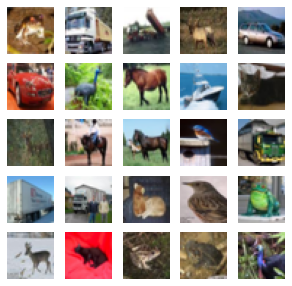
model, losses = train_instance(opt)
[Epoch 0/30] [Batch 0/391] [loss: 1.502118]
[Epoch 1/30] [Batch 109/391] [loss: 0.133310]
[Epoch 2/30] [Batch 218/391] [loss: 0.095016]
[Epoch 3/30] [Batch 327/391] [loss: 0.079812]
[Epoch 5/30] [Batch 45/391] [loss: 0.071379]
[Epoch 6/30] [Batch 154/391] [loss: 0.065934]
[Epoch 7/30] [Batch 263/391] [loss: 0.062047]
[Epoch 8/30] [Batch 372/391] [loss: 0.059087]
[Epoch 10/30] [Batch 90/391] [loss: 0.056777]
[Epoch 11/30] [Batch 199/391] [loss: 0.054932]
[Epoch 12/30] [Batch 308/391] [loss: 0.053386]
[Epoch 14/30] [Batch 26/391] [loss: 0.052062]
[Epoch 15/30] [Batch 135/391] [loss: 0.050902]
[Epoch 16/30] [Batch 244/391] [loss: 0.049908]
[Epoch 17/30] [Batch 353/391] [loss: 0.048988]
[Epoch 19/30] [Batch 71/391] [loss: 0.048224]
[Epoch 20/30] [Batch 180/391] [loss: 0.047470]
[Epoch 21/30] [Batch 289/391] [loss: 0.046828]
[Epoch 23/30] [Batch 7/391] [loss: 0.046280]
[Epoch 24/30] [Batch 116/391] [loss: 0.045746]
[Epoch 25/30] [Batch 225/391] [loss: 0.045249]
[Epoch 26/30] [Batch 334/391] [loss: 0.044794]
[Epoch 28/30] [Batch 52/391] [loss: 0.044376]
[Epoch 29/30] [Batch 161/391] [loss: 0.043983]
gen_imgs, steps = sample_image(model, None, opt, saveimg=False)
gen_imgs = gen_imgs.detach().cpu().numpy().transpose(0, 1, 3, 4, 2)
plot_gen_imgs(gen_imgs)
